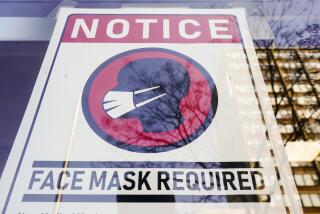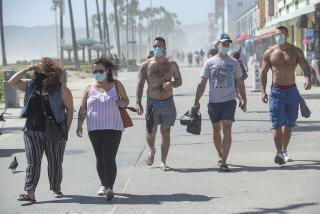Masks tested for flu protection -- and stigma
- Share via
ANN ARBOR, MICH. — In her dorm at the University of Michigan, Denise Rowe looks as much like a patient as a student.
Before she eats a meal, goes to sleep at night, or even kisses her boyfriend, she first has to slip off the blue surgical mask that covers her nose and mouth and hooks around her ears.
Don’t freshmen already have enough pressure to fit in?
“People do kind of look at you weird,” said Rowe, 18, her mouth moving behind the cotton mask.
Around the Ann Arbor campus this winter, 1,400 students have been participating in a study to learn whether wearing masks makes a difference in who gets the flu. About 830 of them are assigned to wear the devices for six weeks, while the rest take no precautions. Some of the mask wearers also use hand sanitizer.
“I felt it was a worthy cause to participate in,” said Rowe, who plans to go to medical school.
The $2-million study, funded by the U.S. Centers for Disease Control and Prevention, is one of several studies worldwide intended to evaluate the feasibility and effectiveness of nonpharmaceutical measures in containing a deadly flu pandemic.
Scientists have said the world is due for a flu epidemic, one that health experts fear could mutate from the H5N1 strain of bird flu.
In the case of such a pandemic, federal officials have said a vaccine may not be available until six months on, making it more important to know the effectiveness of other measures, such as masks and hand washing, in controlling the disease.
But the first year of the CDC study, which ends this week, may reveal as much about slacker students as it does about science. Though 187 residents in one dorm had enrolled in the project, students this past week said they rarely saw anyone wearing the masks anymore.
“It’s hard to breathe with them on,” said Kelly Patrick, 18.
Study co-investigator Allison Aiello, assistant professor of epidemiology at the university’s School of Public Health, said she’s not concerned about lax participation.
She said students have been filling out weekly surveys about their health, the amount of time spent wearing the masks and the reasons for not wearing them, including embarrassment and discomfort. Observers also are stationed in the dorms and cafeterias to watch how many students are wearing the masks -- and wearing them correctly.
Researchers said the project will be valuable either way: The study may find that while masks help prevent the spread of the flu and other respiratory illnesses, they may not be a viable option because people won’t use them.
“There seems to be good acceptance of mask-wearing in many Asian countries, but there needs to be more research on the stigma associated with it here in the U.S. That is one of the things we want to try to get at in this study,” Aiello said.
“That is the aim here, to get some better information on whether these sorts of things will make a difference,” said Dr. Stephen Waterman, a medical epidemiologist at the CDC.
Tomas Aragon, director of the Center for Infectious Disease Preparedness at the UC Berkeley School of Public Health, said it’s hard to study disease prevention using healthy subjects because they may not feel threatened enough to change their behavior.
“It might well be that in the real world ... people are unwilling to wear a mask until maybe there is a real threat right upon them,” Aragon said.
And even among those who wear them, how soon will they take them off?
“How good is a mask when you throw a large pizza in the middle of the table in the dorm?” asked Dr. Steven Wolinsky, chief of infectious diseases at Northwestern University.
That’s what the Michigan researchers hope to learn after collecting data from seven dorms, where students eat, sleep, study and socialize in close quarters.
Study coordinators lured participants with money and the chance to win iPods.
The mask wearers will get $100 at the end of the study, while those in the control group will get $40.
It even pays to get sick. Students who feel ill and get their throat swabbed to check for influenza get an additional $25.
But recruiters fell short of their goal of 2,250 participants. It’s also been a relatively mild flu season, which could affect the project.
The study will be repeated during next winter’s flu season, and Aiello said she expects greater participation because there will be more time to recruit. The CDC didn’t announce funding for the project until October, leaving little time to enroll students before the first flu cases were confirmed in the dorms in late January.
Jelani Bayi, 18, was one of the first to sign up. While he said two of his friends have stopped participating, Bayi hasn’t slacked off.
“I don’t think it’s embarrassing. Everyone knows why I’m wearing it,” Bayi said. Plus, he said, “I haven’t had a cold this whole time.”
Sophomore Jeff Bartels wasn’t as fortunate. He wore the mask for about a week in February, but then he stopped putting it on. Soon after, he got sick.
“I put it back on for the sake of people around me,” he said.
Study participant Rowe, who said she wears the mask eight hours a day, said she’s upset that her dorm-mates aren’t taking the study as seriously.
But, then again, she’s not looking for a date.
Her boyfriend, 18-year-old Bradley Larson, also is in the study, and they wear their masks when they’re watching television, studying, or waiting in line in the dorm’s dining hall.
They even won a photo contest with a picture of their lips touching from behind the masks.
Under the photo was a message: “Always wear protection.”





